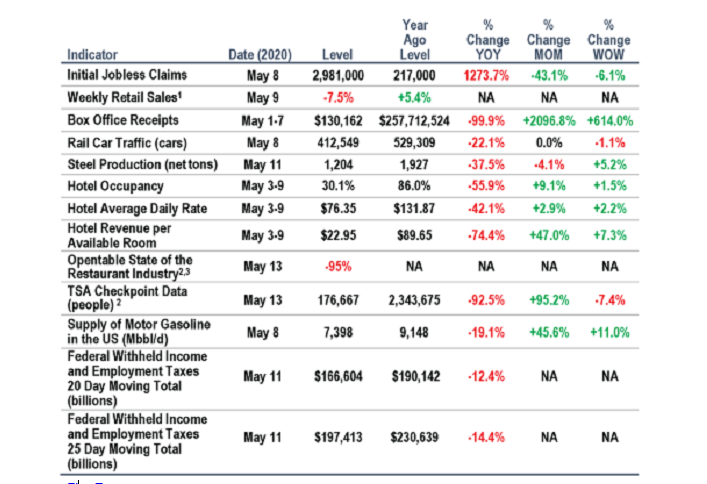Mark Lazar’s May 2020 Newsletter
Blessed are the young, for they shall inherit the national debt. Herbert Hoover
Let’s start with the bad news; unemployment claims currently exceed 36 million, industrial production fell by 11.2% in April, the largest drop in the 101 year history of the index. Retail sales were down 16.4% for the same month, the stock market erased $12 trillion in wealth within the five weeks ending March 23, US debt just topped $25 trillion, and the Atlanta Fed is now forecasting a Q2 economic drop of 42.8%. Holy, cow, Batman!
*All hyperlinked data as of 5/17/2020
But wait! If everything is doom and gloom, why has the market jumped 27% from the March low? It’s important to remember the market is both efficient and forward-looking. The market isn’t concerned with what happens to today—it’s already priced in all of the bad news referenced at the beginning of this missive. Rather, the market is looking ahead 6–9 months, and sometimes longer. Furthermore, the market is an unbiased price mechanism, meaning it doesn’t care about Democrats or Republicans, or the latest headlines on Fox News or CNN. It doesn’t give two hoots about supposed experts, nor their prognostications as to what tomorrow will bring. What does drive the market, then? Expectations. Expectations of future employment, wages, revenues, fiscal policy, trade policy, geopolitical events and, ultimately, corporate earnings. Which is why we can be in the midst of a barrage of bad news, but if it’s less bad than the market expected (priced in), markets move higher. Conversely, if the news is worse/not as good as the market anticipated, security prices move lower.
It would be easy to fall into a pit of despair simply reading the current myriad of sky is falling headlines; however, below are some recent high-frequency data points. While the YOY data is dreadful, you’ll notice some big improvements in most of the WOW and MOM stats, including jobless claims, box office receipts, steel production, and hotel occupancy, to name a few. This is why the stock market has been trending sharply higher since the March 23 lows—in the midst of what appeared to be the beginning of the zombie apocalypse, Mr. Market was correctly forecasting a brighter tomorrow.

First trust
There’s another factor that may be contributing to the market’s violent and somewhat perplexing recovery; TINA, or there is no alternative. When you think about it, there are only a handful of places someone can invest their money with the expectation returns could exceed inflation over time: stocks, corporate bonds/preferred stocks, investment property, precious metals, collectibles, alternative assets, and direct business ownership (e.g. Subway franchise, car wash, laundromat, etc.).
As Tina Turner famously crooned, “What’s love got to do with it?” Investors may not love the stock market these days, but when compared to other investments, stocks appear to be, relatively speaking, the pick of the litter.
Mark Lazar, MBA
Certified Financial Planner®
www.pathwaytoprosperity.com
What’s Love Got to Do With It?
Mark Lazar’s May 2020 Newsletter
Blessed are the young, for they shall inherit the national debt. Herbert Hoover
Let’s start with the bad news; unemployment claims currently exceed 36 million, industrial production fell by 11.2% in April, the largest drop in the 101 year history of the index. Retail sales were down 16.4% for the same month, the stock market erased $12 trillion in wealth within the five weeks ending March 23, US debt just topped $25 trillion, and the Atlanta Fed is now forecasting a Q2 economic drop of 42.8%. Holy, cow, Batman!
*All hyperlinked data as of 5/17/2020
But wait! If everything is doom and gloom, why has the market jumped 27% from the March low? It’s important to remember the market is both efficient and forward-looking. The market isn’t concerned with what happens to today—it’s already priced in all of the bad news referenced at the beginning of this missive. Rather, the market is looking ahead 6–9 months, and sometimes longer. Furthermore, the market is an unbiased price mechanism, meaning it doesn’t care about Democrats or Republicans, or the latest headlines on Fox News or CNN. It doesn’t give two hoots about supposed experts, nor their prognostications as to what tomorrow will bring. What does drive the market, then? Expectations. Expectations of future employment, wages, revenues, fiscal policy, trade policy, geopolitical events and, ultimately, corporate earnings. Which is why we can be in the midst of a barrage of bad news, but if it’s less bad than the market expected (priced in), markets move higher. Conversely, if the news is worse/not as good as the market anticipated, security prices move lower.
It would be easy to fall into a pit of despair simply reading the current myriad of sky is falling headlines; however, below are some recent high-frequency data points. While the YOY data is dreadful, you’ll notice some big improvements in most of the WOW and MOM stats, including jobless claims, box office receipts, steel production, and hotel occupancy, to name a few. This is why the stock market has been trending sharply higher since the March 23 lows—in the midst of what appeared to be the beginning of the zombie apocalypse, Mr. Market was correctly forecasting a brighter tomorrow.
First trust
There’s another factor that may be contributing to the market’s violent and somewhat perplexing recovery; TINA, or there is no alternative. When you think about it, there are only a handful of places someone can invest their money with the expectation returns could exceed inflation over time: stocks, corporate bonds/preferred stocks, investment property, precious metals, collectibles, alternative assets, and direct business ownership (e.g. Subway franchise, car wash, laundromat, etc.).
As Tina Turner famously crooned, “What’s love got to do with it?” Investors may not love the stock market these days, but when compared to other investments, stocks appear to be, relatively speaking, the pick of the litter.
Mark Lazar, MBA
Certified Financial Planner®
www.pathwaytoprosperity.com